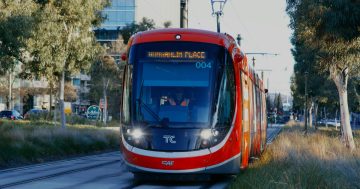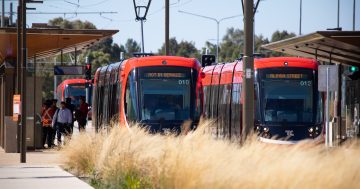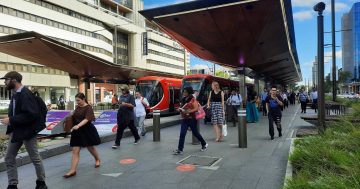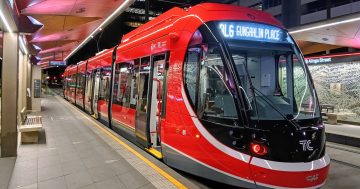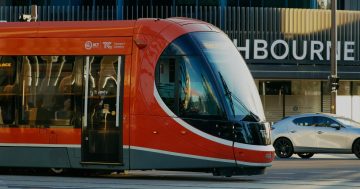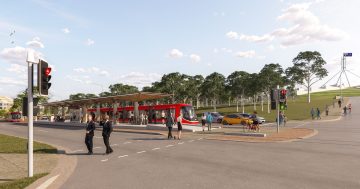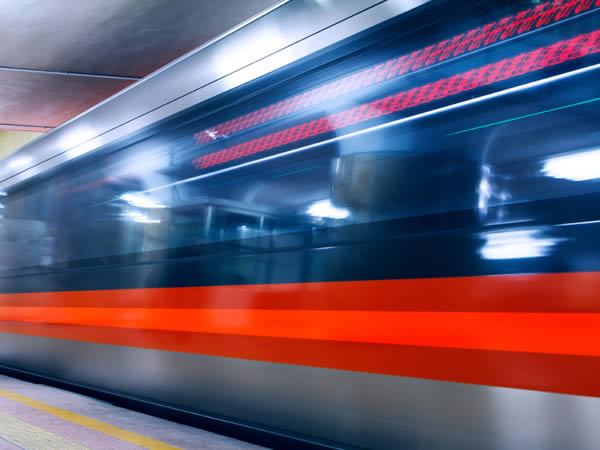
Talk of a bullet train between Canberra and Sydney has been bubbling away for some time now. How do these plans compare to light rail and which is more important to Canberra? We asked Damien Haas (Chair of ACT Light Rail) and Tim Bohm (President, Bullet Train for Australia Party) the following question and their answers are below.
Given the current financial climate, are our municipal funds better spent on light rail or a bullet train?
Damien Haas
Chair of ACT Light Rail

Comparing the two is the classic apples to oranges cliché, as they are very different transport solutions with little in common aside from rails. However, that is what Riot Act has requested.
For the short and long term benefit of the ACT ratepayer, it is better to build Capital Metro from Gungahlin to Civic, and eventually across Canberra, than a bullet train.
Planning and engineering studies for light rail are well underway. Construction costs can be estimated, as building light rail is a standard and routine engineering task in Australia. Aside from conceptual feasibility studies, no similar work has been performed for bullet trains. If it was ever built, it may never come here, instead running directly between Melbourne and Sydney.
Investing in light rail is not the challenge many believe. The ACT will receive 4.4 billion dollars this year from the Federal government, an amount rising incrementally every year. In this context a public transport investment of 600 million over 4 years is fiscally prudent and a sound long-term investment in a growing city.
Light rail has strong electoral support, with the parties taking it to the 2012 Assembly election forming government. Individuals campaigning for bullet trains attracted a handful of votes, as bullet trains provide few clear benefits. Regular polling conducted since consistently shows a majority of Canberrans supporting light rail. Canberrans understand the short and long term benefits.
The use of public money for any project requires careful consideration using triple bottom line analysis – economic, environmental and societal. In each area Capital Metro delivers immediate and long-term benefits to Canberra, that bullet trains can’t match.
Light rail will provide direct economic benefit in the ACT enhancing productivity, freeing families from needing a second car and allowing parking space to be better used. Increased patronage and retasked
ACTION buses will lead to a decrease in the public transport subsidy. Many construction jobs will be immediately created.
Transit oriented development will act as an economic growth driver. Businesses will establish themselves along the corridor knowing that parking wont be required for all staff, and that clients can visit them with ease.
Light rail will alleviate road congestion, mitigate future road construction costs and lead to a reversal in falling public transport patronage by attracting new passengers. Tourists visiting the nations capital will no longer get lost on the wrong bus.
Increased density along the corridor will lead to more walking, and a rise in the number of small businesses to service the needs of new residents. As Capital Metro expands across Canberra, this will be
repeated.
The longer term benefits of light rail will be seen as its influence in shaping Canberras growth and culture emerge over several decades. Those preferring a suburban house and backyard will still have that
option, but people seeking an apartment style of living will have that option in more quantity, and at lower cost.
Bullet trains may be wonderful technology and one day in the future deserving of finance, however the immediate priority for Canberra’s ratepayers is not visiting Sydney in 30 minutes, but commuting to work
in 30 minutes.
Damien Haas is the Chair of ACT Light Rail, the Capital regions peak public transport lobby group. It has been lobbying for light rail and improved public transport since the early 1990’s. It has a webpage at
www.actlighrail.info and a very active facebook page at ‘Light rail for Canberra’ https://www.facebook.com/groups/actlightrail/
Tim Bohm
President, Bullet Train for Australia Party

23 mins to Gungahlin or 57 mins to Sydney?
I want to state from the start that I think light rail would be great to have. But do we need it right now? Light rail from Gungahlin to Civic will be great for 20,000 Canberrans, whereas a Bullet Train connecting Canberra to Sydney will benefit 400,000+ Canberrans and surrounding residents.
Light rail and high-speed-rail (HSR) have very similar benefits. Jobs, environmental benefits, economic benefits, cutting the reliance on cars etc etc. The main difference being, all benefits are magnified for high-speed-rail. The latest Federal Government report stated that investment in HSR would return $2.30 to the community for every dollar spent, whereas the light rail is being reported as being as low as $0.43 to $1.02 return.
Why does Gungahlin to Civic need a 12km light rail route? Surely a dedicated bus lane with an express service down Northbourne would be just as quick as light rail, cost less and be more flexible.
Does Canberra need quicker and faster interstate travel options? YES. Would increased access to Canberra help stop public service jobs and departments being shipped interstate? YES. Would HSR open up Canberra to new tourist markets and interstate commuters? YES. Does Canberra and Australia need a brand new industry now more than ever? YES.
Over 1 million people fly between Canberra and Sydney every year and with SYD to MELB being the 5th busiest route in the world it’s hard to claim HSR would not have the passengers to support it. Where as Light Rail from Gungahlin to Civic will be flat out trying to get enough passengers to ensure the whole thing doesn’t turn into a billion dollar white elephant.
HSR will happen and when it does will the ACT be able to fund it’s share of the costs along side the NSW, QLD, VIC and Federal Governments or will our commitment of $65 million per year for 15 years for a 12km of track between Gungahlin and Civic mean we can’t afford it?
The government should be looking at all public transport options and future needs of the city rather than blindly committing to 12km of light rail just to be in power for 4 years. Lets not waste a billion dollar opportunity, if Gungahlin to Civic goes ahead and fails, no government in the ACT will ever spend the same amount of time, money and resources on public transport ever again.
Our local and federal politicians have the opportunity to make HSR happen now for all Canberrans and all Australians. All it would take is for the government to put in half as much of the energy and resources that they have into light rail and I am confident we would be on our way to getting Australia’s next and most important piece of infrastructure up and running.
Alternatively, our politicians could continue to think in three and four year election cycles, play games with each other and completely ignore the need for HSR and the huge benefits, it would bring to every single Canberran now and for future generations.
A born and bred Canberran, Tim has been waiting his whole life for high-speed-rail, sick of waiting Tim and some friends set up the Bullet Train for Australia party.














